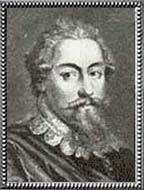
 Francis Beaumont was born third
son of Francis Beaumont, justice of the Court of
Common Pleas, at Grace-Dieu, Leicestershire, in 1584. He entered
Broadgates Hall (now Pembroke College), Oxford in 1597 with his
brothers Henry and John, but left without taking a degree and entered
the Inner
Temple to study law in 1600. It seems, however, that he studied
little, and there is no evidence of him ever practising law. Francis Beaumont was born third
son of Francis Beaumont, justice of the Court of
Common Pleas, at Grace-Dieu, Leicestershire, in 1584. He entered
Broadgates Hall (now Pembroke College), Oxford in 1597 with his
brothers Henry and John, but left without taking a degree and entered
the Inner
Temple to study law in 1600. It seems, however, that he studied
little, and there is no evidence of him ever practising law.
Beaumont's first published verse was prefaced to
his brother John Beaumont's The Metamorphosis of Tobacco
(1602). The same year saw the publication of Salmacis
and Hermaphroditus (1602), a sub-erotic Ovidian epyllion. It appears Beaumont began spending
his time at the Mermaid
Tavern, befriending Ben Jonson. By
1607, Beaumont was referring to Jonson as his "dear friend" in the
verses prefixed to Jonson's Volpone, and Jonson, equally
affectionately, replied:
"How do I love thee, Beaumont, and thy Muse!"
It is not known exactly when Beaumont met John Fletcher,
nor whether they met at the Mermaid, through Jonson, or through a
company for which both were writing, but their collaboration in
playwriting would become famous. They may have started collaborating as
early as 1605, the year in which Beaumont's first play, the prose
comedy The
Woman Hater was written for the popular children's
company Boys of St. Paul's. They were certainly working together
from 1607 onwards, even though it is now generally accepted that
Beaumont was the sole author of The
Knight of the Burning Pestle (1607), a witty comedy.
Beaumont and Fletcher apparently replaced
Shakespeare around 1609 as chief dramatists of the King's Men. In quick
succession they wrote Philaster
(c.1609), The
Maid's Tragedy (c.1610), and A King
and No King (1611). Beaumont and Fletcher seem to have been very in
touch with the popular taste, and were able to cater to it brilliantly,
writing one success after another. Next, they wrote Cupid's Revenge
(c.1611), The Coxcomb (1612), The Scornful Lady
(c.1613) and The Captain (1613).
The promising partnership came to an end quite
soon, however, when Beaumont married an heiress, Ursula Isley of
Sundridge, in 1613 and left the stage. Of the 50 or so plays ascribed
to Beaumont and Fletcher, only seven or eight can be confidently said
to be Beaumont's work in any significant part. Francis Beaumont died
suddenly of a fever in 1616 and was mourned by many, not least by his
closest friend, Fletcher. Beaumont was buried in Westminster Abbey.
The first collected edition of the plays of Beaumont and Fletcher came
out in 1647.
Editions and Criticism
- Appleton, William W. Beaumont and
Fletcher: A Critical Study.
Fair Lawn: Allen and Unwin, 1956.
- Bentley, Gerald Eades. The
Jacobean and Caroline Stage. 7 vols.
Oxford: Oxford University Press, 1940-1968.
- Bentley, Gerald Eades. The
Profession of Dramatist in Shakespeare's Time, 1590-1642.
- Bliss, Lee. Francis Beaumont.
Boston: Twayne Publishers, 1987.
- Bowers, Fredson, gen. ed. The
Dramatic Works in the Beaumont and Fletcher Canon
Cambridge, Cambridge U.P., 1966-
- Ellis-Fermor, Una. The Jacobean
Drama.
London: Methuen (1936), 1965 [see Chapter XI]
- Evans, G. Blakemore. Elizabethan-Jacobean
Drama : The Theatre in Its Time
New York : New Amsterdam Books, 1988.
- Glover, A. and Waller, A.R. The
Works of Francis Beaumont and John Fletcher. 10 volumes.
Cambridge: Cambridge University Press, 1905-12.
A newer edition under Fredson Bowers started in 1966.
- Macaulay, George Campbell. Francis
Beaumont: A Critical Study.
New York: Lemma Publishing Corp., 1972.
- Maxwell, Baldwin. Studies in
Beaumont, Fletcher, and Massinger.
Chapel Hill: University of North Carolina Press, c.1939.
Reprinted New York: Octagon Books, 1966, 1974.
- McKeithan, Daniel. Debt
to Shakespeare in the Beaumont and Fletcher Plays
New York: AMS Press, 1970 [c1938]
- Oliphant, E.H.C. The
Plays of Beaumont and Fletcher; An Attempt To Determine
Their Respective Shares And The Shares Of Others.
Oxford: Oxford University Press, 1927.
- Thorndike, Ashley Horace. The
influence of Beaumont and Fletcher on Shakspere
New York : AMS Press, 1966. [1901].
- Waith, E.M. The Pattern of
Tragicomedy in Beaumont and Fletcher.
New Haven: Yale University Press, 1952.
- Wilson, John Harold. The
Influence of Beaumont and Fletcher on Restoration Drama. New York:
Haskell House, 1969.
Sources:
- Bliss, Lee. Francis Beaumont.
Boston: Twayne Publishers, 1987.
- English Literature: An Illustrated
Record. Vol II, part II.
Richard Garnett and Edmund Gosse, Eds.
New York: The MacMillan Company, 1904.
- The
Cambridge Guide to Literature in English. Ian Ousby, Ed.
Cambridge, Cambridge University Press, 1998. 67.
|


